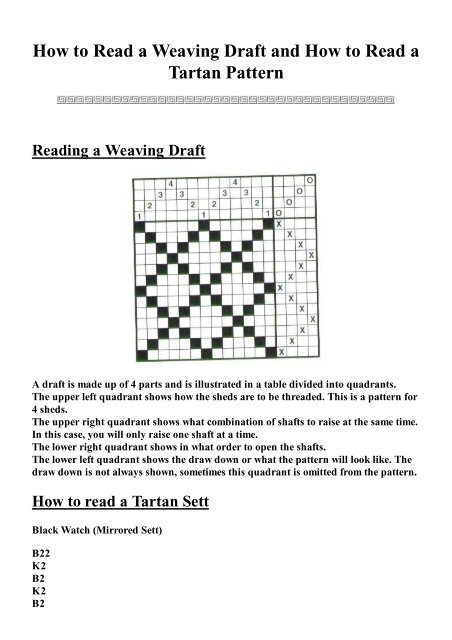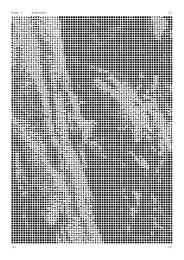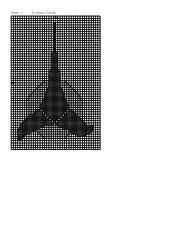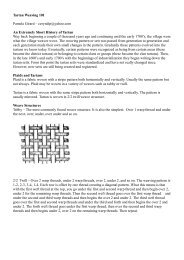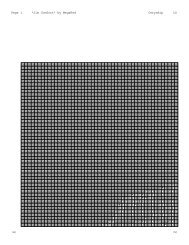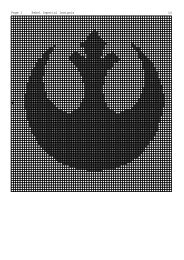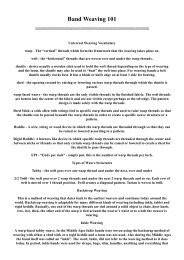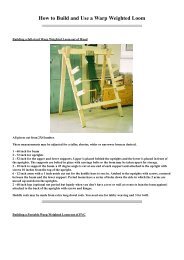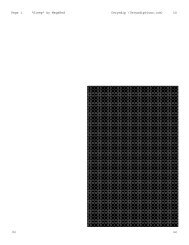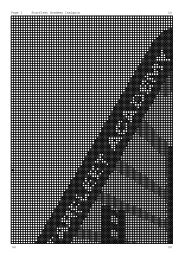How to Read a Weaving Draft and How to Read a Tartan Pattern
How to Read a Weaving Draft and How to Read a Tartan Pattern
How to Read a Weaving Draft and How to Read a Tartan Pattern
You also want an ePaper? Increase the reach of your titles
YUMPU automatically turns print PDFs into web optimized ePapers that Google loves.
<strong>How</strong> <strong>to</strong> <strong>Read</strong> a <strong>Weaving</strong> <strong>Draft</strong> <strong>and</strong> <strong>How</strong> <strong>to</strong> <strong>Read</strong> a<br />
<strong>Tartan</strong> <strong>Pattern</strong><br />
<strong>Read</strong>ing a <strong>Weaving</strong> <strong>Draft</strong><br />
A draft is made up of 4 parts <strong>and</strong> is illustrated in a table divided in<strong>to</strong> quadrants.<br />
The upper left quadrant shows how the sheds are <strong>to</strong> be threaded. This is a pattern for<br />
4 sheds.<br />
The upper right quadrant shows what combination of shafts <strong>to</strong> raise at the same time.<br />
In this case, you will only raise one shaft at a time.<br />
The lower right quadrant shows in what order <strong>to</strong> open the shafts.<br />
The lower left quadrant shows the draw down or what the pattern will look like. The<br />
draw down is not always shown, sometimes this quadrant is omitted from the pattern.<br />
<strong>How</strong> <strong>to</strong> read a <strong>Tartan</strong> Sett<br />
Black Watch (Mirrored Sett)<br />
B22<br />
K2<br />
B2<br />
K2<br />
B2
K16<br />
G16<br />
K2<br />
G16<br />
K16<br />
B16<br />
K2<br />
B2<br />
This is the pattern for the Black Watch <strong>Tartan</strong>. The letters refer <strong>to</strong> colors (B = blue, K<br />
= black, G = green) The numbers refer <strong>to</strong> how many threads of that color are used at<br />
a time. This tartan like many others has a mirrored pattern, which means that you<br />
start with B22 <strong>and</strong> work down through the last B2, then instead of starting over from<br />
the <strong>to</strong>p, you reverse the pattern <strong>and</strong> begin working up from the bot<strong>to</strong>m back <strong>to</strong> the<br />
<strong>to</strong>p <strong>and</strong> then start down again. The pattern pivots on the B2 at the bot<strong>to</strong>m <strong>and</strong> the<br />
B22 at the <strong>to</strong>p, you do not repeat the first <strong>and</strong> last colors when you change directions.<br />
This pattern is followed for both the warp <strong>and</strong> the weft.<br />
For a larger plaid pattern, double the number of threads from what is shown in the<br />
pattern. For a smaller plaid pattern, half the number of threads from what is shown<br />
in the pattern.<br />
<strong>Tartan</strong>s are woven in 2/2 Twill. They should be as closely woven as possible <strong>to</strong> make<br />
the pattern as square as possible. Use heavy tension on the loom. If possible, use a<br />
temple <strong>to</strong> keep the cloth spread the full width of the reed. Wetting the cloth after it is<br />
woven may help nudge the threads in<strong>to</strong> even position with each other.<br />
St<strong>and</strong>ard List of Colors<br />
A = Light Blue (Azure)<br />
B = Blue<br />
C = Rose<br />
D = Dark (+ color)<br />
G = Green<br />
K = Black<br />
L = Light (+ color)<br />
Lil = Lilac<br />
Lv = Lavender<br />
Ma = Magenta<br />
Mn = Maroon<br />
N = Grey (Neutral)<br />
P = Purple<br />
R = Scarlet (red)<br />
T = Brown (tan)<br />
W = White<br />
Y = Yellow
Bibliography<br />
Ch<strong>and</strong>ler, Deborah. Learning <strong>to</strong> Weave. Lovel<strong>and</strong>, Co: Interweave Press. 1995. ISBN<br />
1-883010-03-9<br />
Clan Heritage - www.tartangenera<strong>to</strong>r.com<br />
Scarlett, James D. The <strong>Tartan</strong> Weaver's Guide. London: Shepheard- Walwyn 1985<br />
ISBN 0-85683-078-X<br />
Unless otherwise noted, all text is copyright 2004 P. Girard<br />
Email the Page Owner


